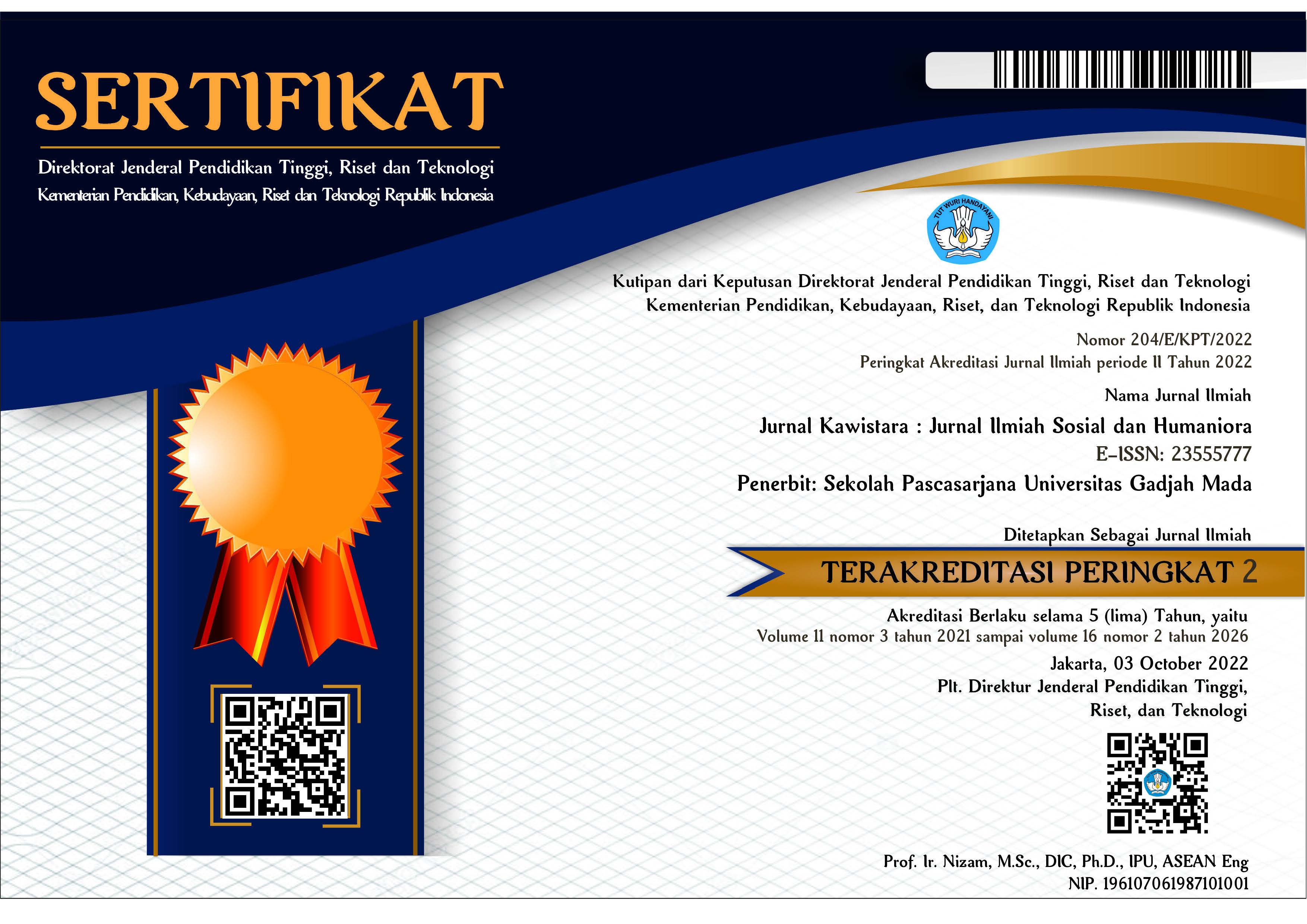Perundungan di Dunia Maya sebagai Perilaku Menyimpang: Analisis Isi Komentar dalam Konten Youtube Keke Bukan Boneka pada Kanal Rahmawati Kekeyi Putri Cantikka
Reza Amarta Prayoga(1*)
(1) Badan Riset dan Inovasi Nasional (BRIN)
(*) Corresponding Author
Abstract
The comment column as an expressive forum on YouTube video sharing media is often used as a ground by netizens to stab comments - comments about "bullying cattle". Killing personal characters, dropping people's dignity, and negative comments tend to be rude, becoming decorations that are easily found and accessed in the comments column on YouTube. This paper specifically describes the behavior of netizens in bullying on Rahmawati Kekeyi Putri Cantikka's youtube channel on the content of the song Keke Bukan Boneka. The method used is descriptive qualitative. The form of data presented in this study is commented (responses or reviews) from citizens contained in the youtube channel. The presentation of the data analysis network in the form of comments using an online application, namely https://netlytic.org, and interpreted based on the theory of cyberbullying behavior proposed by Willard and the theory of deviant behavior from the combination of perspectives of James Vender Zender, Bruce J Cohen, and Robert M.Z. Lawang. The results of this study show that first, the content of the song Keke Bukan Boneka is used as an arena decorated with flaming, harassment, and denigration-type bullying comments on the figure of Kekeyi and trapped in a vortex of deviant behavior. Second, the network of bullying accounts is involved in enlivening the comment column, allegedly as a way to go viral the content of the song. Third, behind the exploitation that accompanied the bullying of Kekeyi, it turned out to be a commodity object to get monetization in the form of fantastic income from YouTube.
Keywords
Full Text:
PDFReferences
1) Adriyanto, A. (2018). KONTROVERSI KETERLIBATAN SOEHARTO DALAM PENUMPASAN G30S/PKI 1965. Kalpataru: Jurnal Sejarah Dan Pembelajaran Sejarah, 2(2), 1–12.
2) Alam, R. N. (2018). Waspada Akun Bot di Media Sosial. MediaIndonesia.Com. https://mediaindonesia.com/teknologi/180586/waspada-akun-bot-di-media-sosial
3) Andriani, F. (2018). Fenomena Social Climber Melalui Twitwar. Jurnal Pustaka Komunikasi, 1(2), 349–360.
4) Arianto, B. (2020). Salah Kaprah Ihwal Buzzer: Analisis Percakapan Warganet di Media Sosial. JIIP: Jurnal Ilmiah Ilmu Pemerintahan, 5(1), 1–20.
5) Arifin, N. F., & Fuad, A. J. (2020). Dampak Post-Truth di Media Sosial. Jurnal Intelektual: Jurnal Pendidikan Dan Studi Keislaman, 10(3), 376–378.
6) Badan Pengembangan dan Pembinaan Bahasa. (2020). KBBI Daring. Badan Pengembangan Dan Pembinaan Bahasa. https://kbbi.kemdikbud.go.id/entri/dajal
7) Blade, S. (2022). rahmawati kekeyi putri cantikka videos mostviewed. Social Blade. https://socialblade.com/youtube/c/rahmawatikekeyiputricantikka/videos/mostviewed
8) Cahyono, A. S. (2016). Pengaruh media sosial terhadap perubahan sosial masyarakat di Indonesia. Jurnal Publiciana, 9(1), 140–157.
9) Christine, G. P., & Rahayu, Y. E. (2019). PENYIMPANGAN KESANTUNAN BERBAHASA PADA KOLOM KOMENTAR DI AKUN INSTAGRAM@ MEMEFILKADA. Jurnal Bahasa Dan Sastra Indonesia, 8(3), 16–24.
10) Destriani, D., Damanhuri, D., & Juwandi, R. (2020). PENGARUH MEDIA SOSIAL TERHADAP PERUBAHAN SIKAP DAN MORAL PESERTA DIDIK DALAM PERSPEKTIF WATAK KEWARGANEGARAAN (CIVIC DISPOSITION). Prosiding Seminar Nasional Pendidikan FKIP, 3(1), 231–240.
11) Febriani, N., & Fadilah, E. (2019). Penerapan Model MonetisasiContent Creation Pada Vice Indonesia. Jurnal Kajian Jurnalisme, 2(2).
12) Febriyanti, S. N., & Tutiasri, R. P. (2018). Etika komunikasi netizen di media sosial. JURNAL ILMU KOMUNIKASI, 1(1).
13) Fitri, J. (2020). Ini 6 Sumber Kekayaan Kekeyi, Makin Dibully Makin Terkenal dan Makin Kaya. Padangkita. https://padangkita.com/ini-6-sumber-kekayaan-kekeyi-makin-dibully-makin-terkenal-dan-makin-kaya/
14) George, A. (2020). The most-viewed YouTube videos of all time. Digitaltrends.Com. https://www.digitaltrends.com/web/most-viewed-youtube-videos/
15) Hadi, A. (2004). Matinya Dunia Cyberspace (Vol. 1). LKIS PELANGI AKSARA.
16) Inderasari, E., Achsani, F., & Lestari, B. (2019). BAHASA SARKASME NETIZEN DALAM KOMENTAR AKUN INSTRAGRAM “LAMBE TURAH.” Semantik, 8(1), 37–49.
17) Indonesia, C. (2019). Goo Hara Meninggal, Netizen Minta Hentikan “Bully” Artis. CNN Indonesia. https://www.cnnindonesia.com/hiburan/20191124185822-234-451071/goo-hara-meninggal-netizen-minta-hentikan-bully-artis
18) Izza, I. (2019). Media Sosial, Antara Peluang dan Ancaman dalam Pembentukan Karakter Anak Didik di Tinjau dari Sudut Pandang Pendidikan Islam. At-Ta’lim: Jurnal Pendidikan, 5(1), 17–37.
19) Jayani, D. H. (2020). 10 Media Sosial yang Paling Sering Digunakan di Indonesia. Katadata.Co.Id. https://databoks.katadata.co.id/datapublish/2020/02/26/10-media-sosial-yang-paling-sering-digunakan-di-indonesia#
20) Kartono, K. (2011). Patologi sosial jilid 1. Jakarta: Rajawali Pers.
21) Kemp, S. (2020). Digital 2020 Report. We Are Social and Hootsuite. https://wearesocial.com/blog/2020/01/digital-2020-3-8-billion-people-use-social-media
22) Kristianto, B. R. D., & Marta, R. F. (2019). Monetisasi dalam strategi komunikasi lintas budaya Bayu Skak melalui video blog YouTube. LUGAS Jurnal Komunikasi, 3(1), 45–56.
23) Microsoft. (2021). Civility, Safety & Interaction Online: Indonesia. https://query.prod.cms.rt.microsoft.com/cms/api/am/binary/RE4MM8l
24) Munir, A., & Harianto, R. (2019). REALITAS PENYIMPANGAN SOSIAL DALAM KONTEKS CYBER SEXUAL HARRASMENT PADA JEJARING SOSIAL LIVE STREAMING BIGO LIVE. SISI LAIN REALITA, 4(2), 21–39.
25) Nugroho, R. S. (2020). Media Asing Soroti Tagar “Indonesia Terserah” yang Viral Terkait Corona. Kompas.Com. https://www.kompas.com/tren/read/2020/05/18/184522865/media-asing-soroti-tagar-indonesia-terserah-yang-viral-terkait-corona?page=all
26) Prajarto, N. (2018). Netizen dan Infotainment: Studi Etnografi Virtual pada Akun Instagram@ lambe_turah. Jurnal Ilmu Komunikasi, 15(1), 33–46. https://doi.org/https://doi.org/10.24002/jik.v15i1.1367
27) Prayoga, R. A., & Khatimah, H. (2019). Pola Pikir Penggunaan Bahasa Inggris Pada Masyarakat Perkotaan di Jabodetabek. Simulacra, 2(1), 39–52. https://doi.org/https://doi.org/10.21107/sml.v2i1.5520
28) Primasti, D., & Dewi, S. I. (2018). Pengaruh Media Sosial Terhadap Penyimpangan Perilaku Remaja (Cyberbullying). Reformasi: Jurnal Ilmiah Ilmu Sosial Dan Ilmu Politik, 7(2).
29) Rauf, M., & Prasetio, A. (2021). Aktivitas Komunikasi Aplikasi Pencarian Jodoh Pada Media Michat. EProceedings of Management, 8(2).
30) Salsabiela, H. (2021). Jangan Ada Social Animal di Medsos. Republika.Id. https://www.republika.id/posts/15367/jangan-ada-social-animal-di-medsos
31) Whittaker, E., & Kowalski, R. M. (2015). Cyberbullying via social media. Journal of School Violence, 14(1), 11–29.
32) Willard, N. (2006). Cyberbullying and cyberthreats. Effectively managing Internet use risks in schools. Center for Safe and Responsible Use of the Internet. https://www.cforks.org/Downloads/cyber_bullying.pdf
33) Wiryada, O. A. B., Martiarini, N., & Budiningsih, T. E. (2017). Gambaran Cyberbullying pada Remaja Pengguna Jejaring Sosial di SMA Negeri 1 dan SMA Negeri 2 Ungaran. Intuisi: Jurnal Psikologi Ilmiah, 9(1), 86–92.
34) Yacob, R. (2020). PENGGUNAAN BAHASA PADA KOLOM KOMENTAR DI YOUTUBE: STUDI KAJIAN AWAL. Seminar Bahasa Dan Sastra Indonesia, 2(1), 169–174. http://conference.unsri.ac.id/index.php/sembadra/article/view/1612
Article Metrics
Refbacks
- There are currently no refbacks.
Copyright (c) 2022 Reza Amarta Prayoga

This work is licensed under a Creative Commons Attribution-ShareAlike 4.0 International License.
Jurnal Kawistara is published by the Graduate School, Universitas Gadjah Mada.







